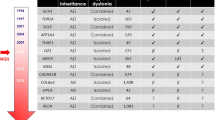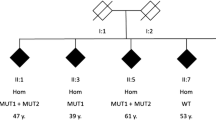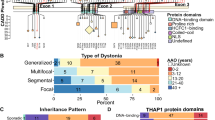Abstract
GNAL was identified as a cause of dystonia in patients from North America, Europe and Asia. In this study, we aimed to investigate the prevalence of GNAL variants in Brazilian patients with dystonia. Ninety-one patients with isolated idiopathic dystonia, negative for THAP1 and TOR1A mutations, were screened for GNAL variants by Sanger sequencing. Functional characterization of the Gαolf protein variant was performed using the bioluminescence resonance energy transfer assay. A novel heterozygous nonsynonymous variant (p. F133L) was identified in a patient with cervical and laryngeal dystonia since the third decade of life, with no family history. This variant was not identified in healthy Brazilian controls and was not described in 63,000 exomas of the ExAC database. The F133L mutant exhibited significantly elevated levels of basal BRET and severely diminished amplitude of response elicited by dopamine, that both indicate substantial functional impairment of Gαolf in transducing receptor signals, which could be involved in dystonia pathophysiology. GNAL mutations are not a common cause of dystonia in the Brazilian population and have a lower prevalence than THAP1 and TOR1A mutations. We present a novel variant that results in partial Gαolf loss of function.


Similar content being viewed by others
References
Albanese A, Bhatia K, Bressman SB et al (2013) Phenomenology and classification of dystonia: a consensus update. Mov Disord 28(7):863–873
Ozelius LJ, Lubarr N, Bressman SB (2011) Milestones in dystonia. Mov Disord 26(6):1106–1126
da Silva-Junior FP, dos Santos CO, Silva SM et al (2014) Novel THAP1 variants in Brazilian patients with idiopathic isolated dystonia. J Neurol Sci 344(1–2):190–192
Fuchs T, Saunders-Pullman R, Masuho I et al (2013) Mutations in GNAL cause primary torsion dystonia. Nat Genet 45(1):88–92
Hervé D (2011) Identification of a specific assembly of the g protein golf as a critical and regulated module of dopamine and adenosine-activated cAMP pathways in the striatum. Front Neuroanat 5:48
Corvol JC, Studler JM, Schonn JS, Girault JA, Hervé D (2001) Galpha(olf) is necessary for coupling D1 and A2a receptors to adenylyl cyclase in the striatum. J Neurochem 76(5):1585–1588
Vemula SR, Puschmann A, Xiao J et al (2013) Role of Gα(olf) in familial and sporadic adult-onset primary dystonia. Hum Mol Genet 22(12):2510–2519
Erro R, Bhatia KP, Hardy J (2014) GNAL mutations and dystonia. JAMA Neurol 71(8):1052–1053
Charlesworth G, Bhatia KP, Wood NW (2014) No pathogenic GNAL mutations in 192 sporadic and familial cases of cervical dystonia. Mov Disord 29(1):154–155
Kumar KR, Martemyanov KA, Lohmann K (2014) GNAL mutations and dystonia–reply. JAMA Neurol 71(8):1053–1054
Masuho I, Martemyanov KA, Lambert NA (2015) Monitoring G protein activation in cells with BRET. Methods Mol Biol 1335:107–113
Saunders-Pullman R, Fuchs T, San Luciano M et al (2014) Heterogeneity in primary dystonia: lessons from THAP1, GNAL, and TOR1A in Amish-Mennonites. Mov Disord 29(6):812–818
Acknowledgments
Study funding: Sao Paulo Research Foundation (FAPESP) Grants # 2010/19206-0 (PCA); 2011/18202-3 (COS); 2013/09867-7(COS), 2014/17128-2(PCA) NIH grant NS081282 (KAM). The authors thank all patients and their families, the Exome Aggregation Consortium and the groups that provided exome variant data for comparison. A full list of contributing groups can be found at http://exac.broadinstitute.org/about.
Author information
Authors and Affiliations
Corresponding author
Ethics declarations
Conflicts of interest
On behalf of all authors, the corresponding author states that there is no conflict of interest.
Ethical standards
This study was approved by the Institutional Review Boards and all subjects provided informed written consent.
Rights and permissions
About this article
Cite this article
dos Santos, C.O., Masuho, I., da Silva-Júnior, F.P. et al. Screening of GNAL variants in Brazilian patients with isolated dystonia reveals a novel mutation with partial loss of function. J Neurol 263, 665–668 (2016). https://doi.org/10.1007/s00415-016-8026-2
Received:
Revised:
Accepted:
Published:
Issue Date:
DOI: https://doi.org/10.1007/s00415-016-8026-2




